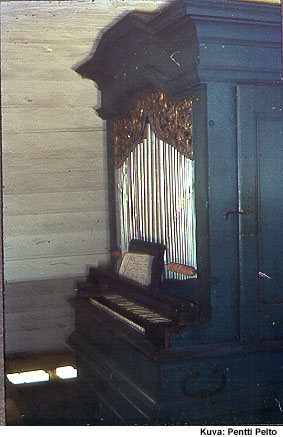
|
HISTORICAL ORGANS IN FINLAND 
Inkoo Fagervik Factory Church- Hedlund, Olof 1726
- 5 stops, 1 manual, no pedal
- mechanical action and mechanical stop action
Swedish organ builder Olof Hedlund, while in the employ of J.N. Cahman, built a six-stop positive. This instrument was purchased by assessor Johan Hising for the Fagervik Factory Church (built by Joh. Friedrich Schulz in 1737) in 1763. The positive was inaugurated on September 29, 1763, after Carl Lenningh, organist of Turku Cathedral, had installed it in the loft of the Factory Church. The organ has a sibling in the Musical History Museum in Copenhagen (CCS nr 588), giving a clue as to the dating of the Fagervik positive. The positive was evidently built in the 1720s. It is not known where it was before it was brought to Fagervik. Still in working order today, the positive remains in its original guise except that its short octave was converted into chromatic by Anders Thulé in connection with repairs in 1843. The positive has been played at special occasions in recent years.
Appearance
The Fagervik positive is about 2 m high, with a case of uniform width divided into a lower and upper section. Each section has wrought-iron handles for lifting and moving. The lower section houses the bellows, pumping pedal, chest and keyboard, while the upper section has the façade and pipes. The façade consists of a single A-shaped flat (Octava 2’), which is in front of the keyboard immediately behind the music stand. The length of the feet of the façade pipes varies greatly, giving the façade an appearance that is curious though typical of its builder and era. Carved decorations together with a large profiled top beam punctuate the façade. The cabinet is painted “Berlin blue”, as Lenningh described it in a letter to Abr. Hülphers.
Positive structure
There are two bellows: the lower, wedge-shaped single-fold bellows is the feeder bellows, worked with the pumping pedal. The upper bellows is the reservoir. It is also wedge-shaped, but has multiple folds. The chest is a lamellar slider chest. The wrought-iron stop levers move laterally.
The suspended keyboard has a short octave in the great octave. The naturals have a bone covering, while the sharps have an ebony covering. The keys open the valves via short stickers. The key fronts of the naturals have a paper decoration: a heraldic double lily different from the usual decorations used by either Cahman or Hedlund.
The pipes of the Fagervik positive are made with care and precision. The façade pipes are of almost pure tin, whereas the internal pipes are, typically for the era, made of an alloy with about one fifth tin and the rest lead.
Because of the short action and the proximity of the pipes to the organist, the instrument is almost harpsichord-like in its precision and lightness. It is easy for the organist to articulate and decorate the music. The small cabinet highlights the precise speaking of the pipes, rendering all details of articulation clearly audible to listeners. The sound of the Cahman school is clearly identifiable. It is not sharp, but not sombre either; it contains a touch of shrillness to add intensity. Because of the small size of the instrument, its sound has a chamber-music feel.
Disposition
Manual E-c3 |
|
|
Gedacht 8' | | |
Octava 4' | | |
Qvinta 3' | | |
Octava 2' | | |
Scharf 3 chor | | |
Original compass C/E-c3. | | |
| | |
| | |
| | |
| | |
| | |
| | |
| | |
Further information
Hülphers, Abr. A:sson: Historisk Afhandling Musik och Instrumenter. Västerås 1773/Stockholm 1969;
Hela, Martti: Vanhojen urkujemme vaiheita. Porvoo 1927;
Martikainen, Juhani: Orglar i Finland från tiden 1600-1800. Dissertation, Sibelius Academy 1997.
Olsson, Birger: Olof Hedlund Orgelbyggare. Göteborg 1998.
|